University Nursing Essay: Patient Deterioration Case Study Analysis
VerifiedAdded on 2022/08/17
|13
|3615
|22
Essay
AI Summary
This essay critically analyzes a nursing case study involving the death of a patient, Michael James Calder, to identify factors leading to patient deterioration and recommend preventive measures. The case study highlights issues such as opioid toxicity, failure to recognize early warning signs, and inadequate adherence to established protocols, including the Modified Early Warning Score (MEWS) chart. Situational factors like the patient's history of sleep apnea being overlooked, persistent declines in oxygen saturation levels, and organizational factors such as high patient loads, staffing issues, and poor team communication contributed to the adverse outcome. The essay emphasizes the importance of nursing skills, comprehensive patient assessment, and effective leadership to improve patient safety. Recommendations include improving nurse-patient ratios, enhancing team communication, and promoting a culture of safety through transformational leadership to prevent similar incidents in the future. The essay underscores the need for healthcare organizations to prioritize patient safety through improved assessment, monitoring, and response to patient deterioration, referencing the Australian Commission on Safety and Quality's standards.
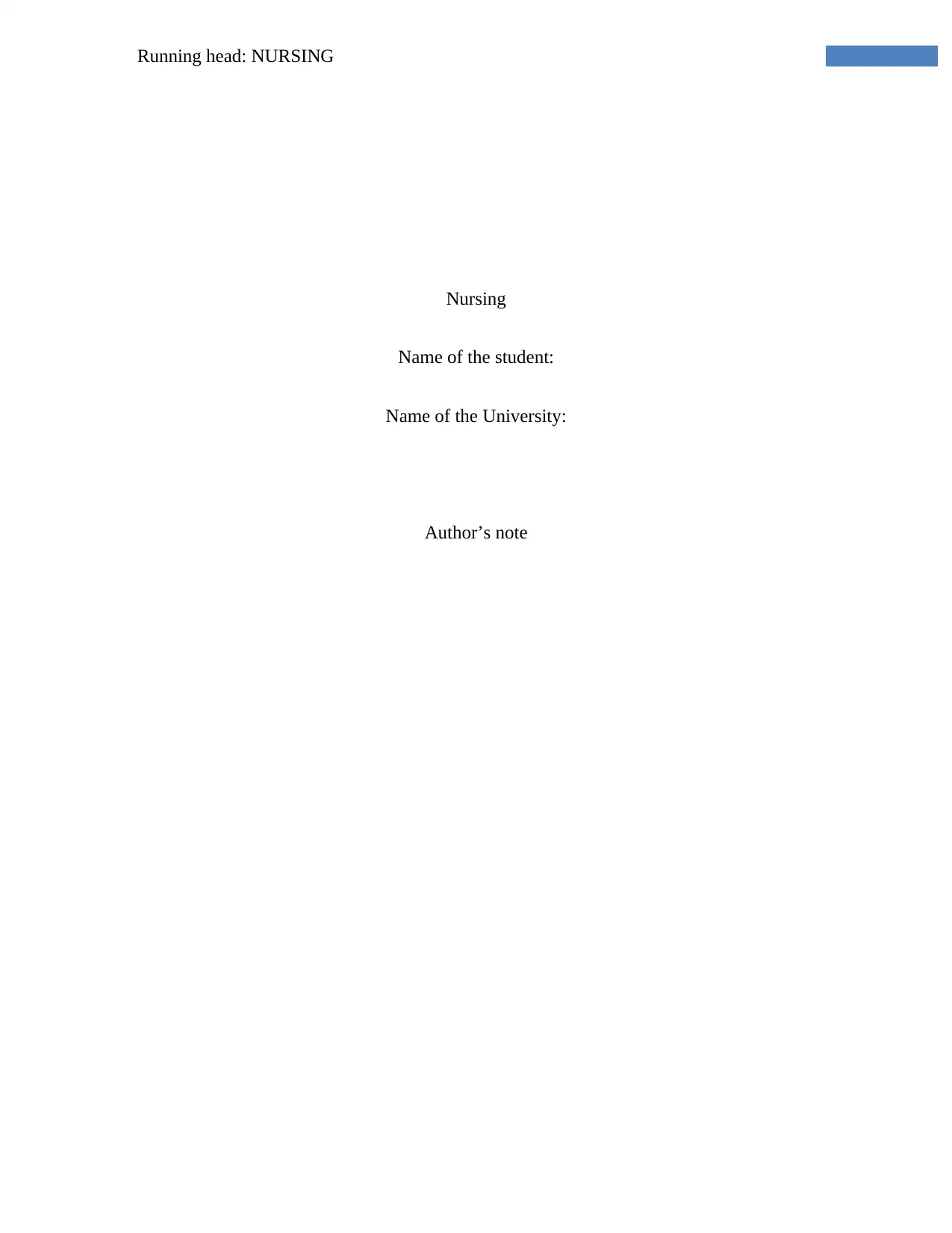
Running head: NURSING
Nursing
Name of the student:
Name of the University:
Author’s note
Nursing
Name of the student:
Name of the University:
Author’s note
Paraphrase This Document
Need a fresh take? Get an instant paraphrase of this document with our AI Paraphraser
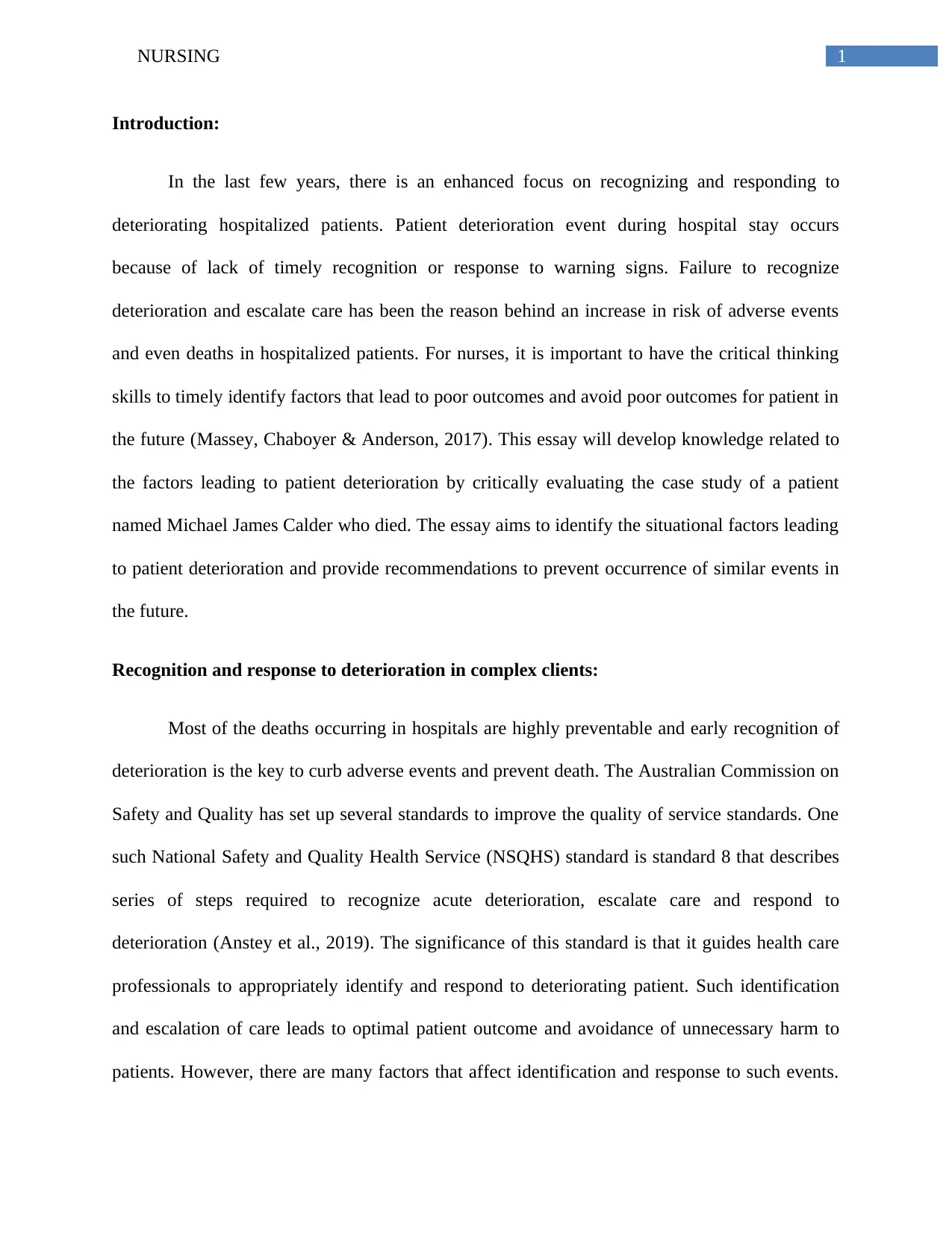
1NURSING
Introduction:
In the last few years, there is an enhanced focus on recognizing and responding to
deteriorating hospitalized patients. Patient deterioration event during hospital stay occurs
because of lack of timely recognition or response to warning signs. Failure to recognize
deterioration and escalate care has been the reason behind an increase in risk of adverse events
and even deaths in hospitalized patients. For nurses, it is important to have the critical thinking
skills to timely identify factors that lead to poor outcomes and avoid poor outcomes for patient in
the future (Massey, Chaboyer & Anderson, 2017). This essay will develop knowledge related to
the factors leading to patient deterioration by critically evaluating the case study of a patient
named Michael James Calder who died. The essay aims to identify the situational factors leading
to patient deterioration and provide recommendations to prevent occurrence of similar events in
the future.
Recognition and response to deterioration in complex clients:
Most of the deaths occurring in hospitals are highly preventable and early recognition of
deterioration is the key to curb adverse events and prevent death. The Australian Commission on
Safety and Quality has set up several standards to improve the quality of service standards. One
such National Safety and Quality Health Service (NSQHS) standard is standard 8 that describes
series of steps required to recognize acute deterioration, escalate care and respond to
deterioration (Anstey et al., 2019). The significance of this standard is that it guides health care
professionals to appropriately identify and respond to deteriorating patient. Such identification
and escalation of care leads to optimal patient outcome and avoidance of unnecessary harm to
patients. However, there are many factors that affect identification and response to such events.
Introduction:
In the last few years, there is an enhanced focus on recognizing and responding to
deteriorating hospitalized patients. Patient deterioration event during hospital stay occurs
because of lack of timely recognition or response to warning signs. Failure to recognize
deterioration and escalate care has been the reason behind an increase in risk of adverse events
and even deaths in hospitalized patients. For nurses, it is important to have the critical thinking
skills to timely identify factors that lead to poor outcomes and avoid poor outcomes for patient in
the future (Massey, Chaboyer & Anderson, 2017). This essay will develop knowledge related to
the factors leading to patient deterioration by critically evaluating the case study of a patient
named Michael James Calder who died. The essay aims to identify the situational factors leading
to patient deterioration and provide recommendations to prevent occurrence of similar events in
the future.
Recognition and response to deterioration in complex clients:
Most of the deaths occurring in hospitals are highly preventable and early recognition of
deterioration is the key to curb adverse events and prevent death. The Australian Commission on
Safety and Quality has set up several standards to improve the quality of service standards. One
such National Safety and Quality Health Service (NSQHS) standard is standard 8 that describes
series of steps required to recognize acute deterioration, escalate care and respond to
deterioration (Anstey et al., 2019). The significance of this standard is that it guides health care
professionals to appropriately identify and respond to deteriorating patient. Such identification
and escalation of care leads to optimal patient outcome and avoidance of unnecessary harm to
patients. However, there are many factors that affect identification and response to such events.

2NURSING
This depends on the knowledge and skills of the health care professionals, their critical thinking
skills, culture of the organization and availability of assessment methods in an organization
(Myers et al., 2017). Many health organizations also have a rapid response team and warning
systems to effectively respond to deteriorating patient. The rapid response system is a detection
mechanism that consists of a crisis detection mechanism to identify deterioration and initiate a
response mechanism that ensures that all teams promptly respond to triggers (McKinney et al.,
2019). However, this system alone does not facilitate prevention of adverse events. Experience
of nurse, communication factors and organization factors also determine how quickly clinical
deterioration is identified and addressed. Ede et al. (2019) supports too that human factors like
situational awareness, team work, communication and safety culture results in avoidance of
failure to rescue events. Thus, health care team must strive to increase efforts to avoid failure to
rescue events while providing care to acute patients.
Case study evaluation:
The case study deals with the investigation into the death of Michael James Calder. Mr.
James was 33 years old and he was referred to the Holy Spirit Northside Private Hospital
(HSNPH) on 8th July, 2014. The events leading to his hospitalization was a three day history of
severe and continuous occipital headaches and complains of neck pain and stiffness. In the
Emergency Department, he was given analgesia along with several total 10 mg of morphines. He
received several types of analgesia for his ongoing headache. He was given two early dose of
morphine on 8th July and 9th July, 2014. According to nursing notes, there were no obvious signs
of narcotization. However, around 4: 40 hours on 11th July, 2014, James was found to be
unresponsive. Despite performing CPR, he could not be resuscitated and he was declared dead at
5: 17 hours. According to autopsy examination, opiate toxicity was found to be the cause of
This depends on the knowledge and skills of the health care professionals, their critical thinking
skills, culture of the organization and availability of assessment methods in an organization
(Myers et al., 2017). Many health organizations also have a rapid response team and warning
systems to effectively respond to deteriorating patient. The rapid response system is a detection
mechanism that consists of a crisis detection mechanism to identify deterioration and initiate a
response mechanism that ensures that all teams promptly respond to triggers (McKinney et al.,
2019). However, this system alone does not facilitate prevention of adverse events. Experience
of nurse, communication factors and organization factors also determine how quickly clinical
deterioration is identified and addressed. Ede et al. (2019) supports too that human factors like
situational awareness, team work, communication and safety culture results in avoidance of
failure to rescue events. Thus, health care team must strive to increase efforts to avoid failure to
rescue events while providing care to acute patients.
Case study evaluation:
The case study deals with the investigation into the death of Michael James Calder. Mr.
James was 33 years old and he was referred to the Holy Spirit Northside Private Hospital
(HSNPH) on 8th July, 2014. The events leading to his hospitalization was a three day history of
severe and continuous occipital headaches and complains of neck pain and stiffness. In the
Emergency Department, he was given analgesia along with several total 10 mg of morphines. He
received several types of analgesia for his ongoing headache. He was given two early dose of
morphine on 8th July and 9th July, 2014. According to nursing notes, there were no obvious signs
of narcotization. However, around 4: 40 hours on 11th July, 2014, James was found to be
unresponsive. Despite performing CPR, he could not be resuscitated and he was declared dead at
5: 17 hours. According to autopsy examination, opiate toxicity was found to be the cause of
⊘ This is a preview!⊘
Do you want full access?
Subscribe today to unlock all pages.

Trusted by 1+ million students worldwide

3NURSING
death. From this report, it can be interpreted that since his hospital admission, he was given high
dose of opiods leading to adverse reaction and accidental death of Mr. Michael James. Opioid
abuse and overdose has received significant national attention in US. Normally, opiates undergo
first-order elimination pharmacokinetics. However, in case of overdose, it leads to conversion of
first order elimination to zero-order elimination. This leads to toxicokinetic effects. Patients with
such problem suffer from respiratory depression and oxygen saturation of less than 90% (Powell
& Peters, 2019). In case of James, the nurses missed the opportunity to identify fall in oxygen
saturation level. His death also occurred due to combined effects of aspiration pneumonia and
effect of opiate toxicity on the central nervous system.
From the critical analysis of the case study, it has been found that several incorrect
decisions were taken or opportunities of care for Mr. Michael were missed. During patient
assessment, it is critical for health care professionals to be aware of past medical history of
patients and its effect on current medical symptoms. The patient had a history of sleep apnoea
and Dr. Brockett was not aware about this. This was one of the major negligence because
according to evidence based guidelines, clinicians prescribing opioids should conduct proper risk
assessment of patient and be aware of risk factors associated with opioids and its overdose. Risk
assessment involves taking a review of medical history and physical examination (Cheatle &
Webster, 2015). However, history of sleep apnea was ignored because of lack of comprehensive
risk assessment. Pain management in patients suffering from sleep apnea is very challenging
because of ventilatory compromise. Such patients are at high risk of respiratory depression
following opioid use (Lam et al. 2016). Michael succumbed to episodes of aspiration and
respiratory depression and this could have been avoided if thorough history checking was done.
death. From this report, it can be interpreted that since his hospital admission, he was given high
dose of opiods leading to adverse reaction and accidental death of Mr. Michael James. Opioid
abuse and overdose has received significant national attention in US. Normally, opiates undergo
first-order elimination pharmacokinetics. However, in case of overdose, it leads to conversion of
first order elimination to zero-order elimination. This leads to toxicokinetic effects. Patients with
such problem suffer from respiratory depression and oxygen saturation of less than 90% (Powell
& Peters, 2019). In case of James, the nurses missed the opportunity to identify fall in oxygen
saturation level. His death also occurred due to combined effects of aspiration pneumonia and
effect of opiate toxicity on the central nervous system.
From the critical analysis of the case study, it has been found that several incorrect
decisions were taken or opportunities of care for Mr. Michael were missed. During patient
assessment, it is critical for health care professionals to be aware of past medical history of
patients and its effect on current medical symptoms. The patient had a history of sleep apnoea
and Dr. Brockett was not aware about this. This was one of the major negligence because
according to evidence based guidelines, clinicians prescribing opioids should conduct proper risk
assessment of patient and be aware of risk factors associated with opioids and its overdose. Risk
assessment involves taking a review of medical history and physical examination (Cheatle &
Webster, 2015). However, history of sleep apnea was ignored because of lack of comprehensive
risk assessment. Pain management in patients suffering from sleep apnea is very challenging
because of ventilatory compromise. Such patients are at high risk of respiratory depression
following opioid use (Lam et al. 2016). Michael succumbed to episodes of aspiration and
respiratory depression and this could have been avoided if thorough history checking was done.
Paraphrase This Document
Need a fresh take? Get an instant paraphrase of this document with our AI Paraphraser

4NURSING
This would have made the clinicians aware about history of sleep apnea and consider the
appropriate dose needed by Michael.
Another situational factors that has been found to be the cause behind Michael’s death is
persistent decline in oxygen saturation level and failure to early signs of clinical deteriorations.
In the context of opioid overdose, oxygen saturation level of 90 % was an early sign of clinical
deterioration. Some of the common clinical manifestations of opioid toxicity includes respiratory
rate of less than 12 breaths per minute and oxygen saturation level of less than 90%. Health care
team can infer signs of overdose by vital signs and physical examination (Boyer, 2012).
However, the night shift nursing staff failed to recognize early signs of deterioration and this
indecisiveness became a reason for unexpected death of patient. According to the NSQHS
standard 8, health service organizations have protocols that specific criteria for escalating care
(ACSQHS, 2017). The protocol for actions to be taken in case of different oxygen saturaton level
was also present at the HSNPH. In the hospital, the Modified Early Warning Score (MEWS)
chart was used to guide nurse to take the required actions in case of different oxygen saturation
values. However, in accordance with this protocol, the RNs did not escalate care when the
oxygen saturation level fell below 90%. This suggests another flaw which is lack of skills and
knowledge of nurse in recognizing early signs of deterioration and escalation of care. Lack of
skills in assessment and monitoring of drug dose deteriorated the condition of Mr. James.
Organizational factors like team work, staffing and communication is also crucial to
prevent patient deterioration and timely respond to negative symptoms of patient. However, in
the case study, it was found that the each nurses had good patient load. For example, during the
night shift, EEN Meadowfair had a patient load of 10 patients. Other registered nurse also had
such patient load. This could be the contributing factor behind care negligence and delay in
This would have made the clinicians aware about history of sleep apnea and consider the
appropriate dose needed by Michael.
Another situational factors that has been found to be the cause behind Michael’s death is
persistent decline in oxygen saturation level and failure to early signs of clinical deteriorations.
In the context of opioid overdose, oxygen saturation level of 90 % was an early sign of clinical
deterioration. Some of the common clinical manifestations of opioid toxicity includes respiratory
rate of less than 12 breaths per minute and oxygen saturation level of less than 90%. Health care
team can infer signs of overdose by vital signs and physical examination (Boyer, 2012).
However, the night shift nursing staff failed to recognize early signs of deterioration and this
indecisiveness became a reason for unexpected death of patient. According to the NSQHS
standard 8, health service organizations have protocols that specific criteria for escalating care
(ACSQHS, 2017). The protocol for actions to be taken in case of different oxygen saturaton level
was also present at the HSNPH. In the hospital, the Modified Early Warning Score (MEWS)
chart was used to guide nurse to take the required actions in case of different oxygen saturation
values. However, in accordance with this protocol, the RNs did not escalate care when the
oxygen saturation level fell below 90%. This suggests another flaw which is lack of skills and
knowledge of nurse in recognizing early signs of deterioration and escalation of care. Lack of
skills in assessment and monitoring of drug dose deteriorated the condition of Mr. James.
Organizational factors like team work, staffing and communication is also crucial to
prevent patient deterioration and timely respond to negative symptoms of patient. However, in
the case study, it was found that the each nurses had good patient load. For example, during the
night shift, EEN Meadowfair had a patient load of 10 patients. Other registered nurse also had
such patient load. This could be the contributing factor behind care negligence and delay in
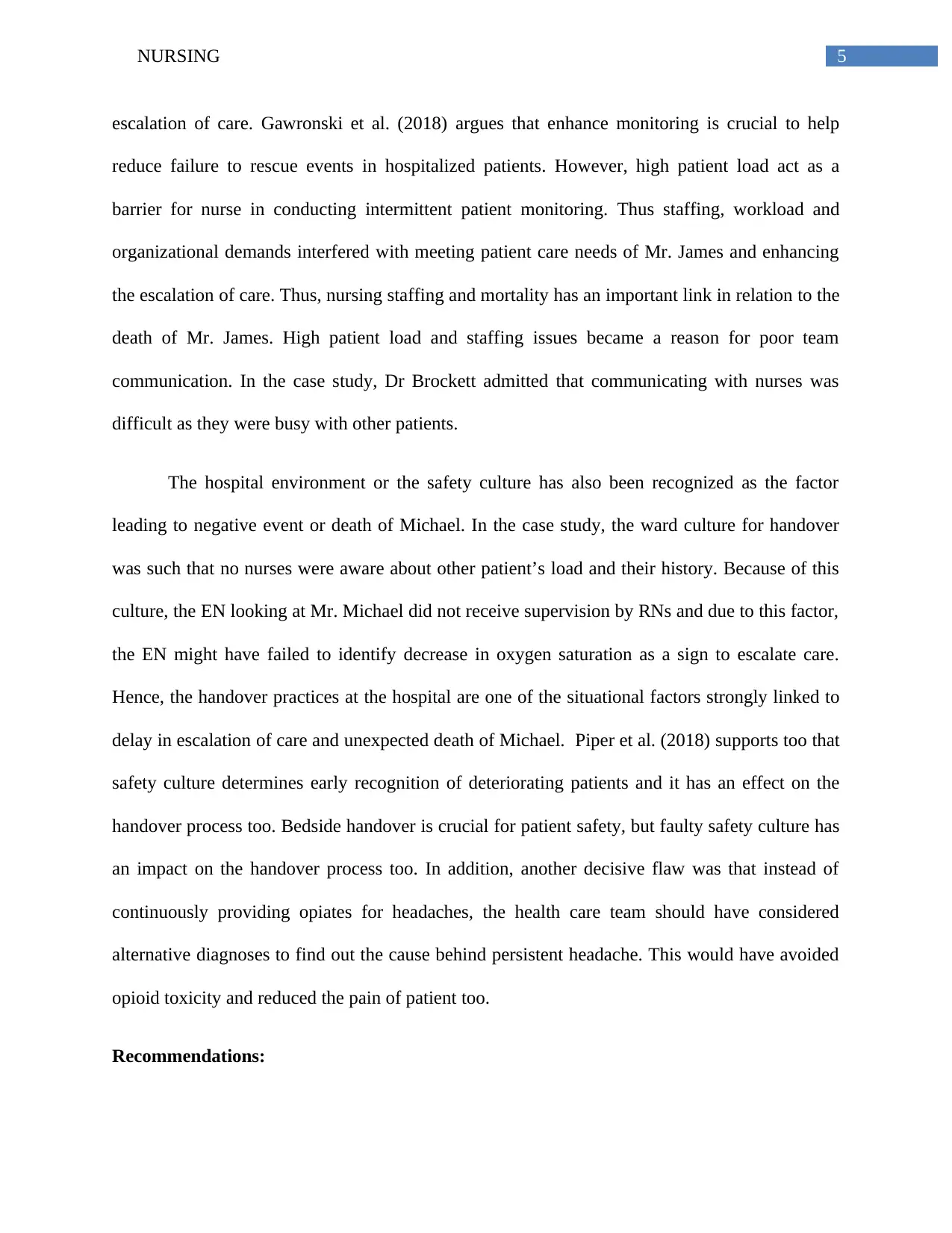
5NURSING
escalation of care. Gawronski et al. (2018) argues that enhance monitoring is crucial to help
reduce failure to rescue events in hospitalized patients. However, high patient load act as a
barrier for nurse in conducting intermittent patient monitoring. Thus staffing, workload and
organizational demands interfered with meeting patient care needs of Mr. James and enhancing
the escalation of care. Thus, nursing staffing and mortality has an important link in relation to the
death of Mr. James. High patient load and staffing issues became a reason for poor team
communication. In the case study, Dr Brockett admitted that communicating with nurses was
difficult as they were busy with other patients.
The hospital environment or the safety culture has also been recognized as the factor
leading to negative event or death of Michael. In the case study, the ward culture for handover
was such that no nurses were aware about other patient’s load and their history. Because of this
culture, the EN looking at Mr. Michael did not receive supervision by RNs and due to this factor,
the EN might have failed to identify decrease in oxygen saturation as a sign to escalate care.
Hence, the handover practices at the hospital are one of the situational factors strongly linked to
delay in escalation of care and unexpected death of Michael. Piper et al. (2018) supports too that
safety culture determines early recognition of deteriorating patients and it has an effect on the
handover process too. Bedside handover is crucial for patient safety, but faulty safety culture has
an impact on the handover process too. In addition, another decisive flaw was that instead of
continuously providing opiates for headaches, the health care team should have considered
alternative diagnoses to find out the cause behind persistent headache. This would have avoided
opioid toxicity and reduced the pain of patient too.
Recommendations:
escalation of care. Gawronski et al. (2018) argues that enhance monitoring is crucial to help
reduce failure to rescue events in hospitalized patients. However, high patient load act as a
barrier for nurse in conducting intermittent patient monitoring. Thus staffing, workload and
organizational demands interfered with meeting patient care needs of Mr. James and enhancing
the escalation of care. Thus, nursing staffing and mortality has an important link in relation to the
death of Mr. James. High patient load and staffing issues became a reason for poor team
communication. In the case study, Dr Brockett admitted that communicating with nurses was
difficult as they were busy with other patients.
The hospital environment or the safety culture has also been recognized as the factor
leading to negative event or death of Michael. In the case study, the ward culture for handover
was such that no nurses were aware about other patient’s load and their history. Because of this
culture, the EN looking at Mr. Michael did not receive supervision by RNs and due to this factor,
the EN might have failed to identify decrease in oxygen saturation as a sign to escalate care.
Hence, the handover practices at the hospital are one of the situational factors strongly linked to
delay in escalation of care and unexpected death of Michael. Piper et al. (2018) supports too that
safety culture determines early recognition of deteriorating patients and it has an effect on the
handover process too. Bedside handover is crucial for patient safety, but faulty safety culture has
an impact on the handover process too. In addition, another decisive flaw was that instead of
continuously providing opiates for headaches, the health care team should have considered
alternative diagnoses to find out the cause behind persistent headache. This would have avoided
opioid toxicity and reduced the pain of patient too.
Recommendations:
⊘ This is a preview!⊘
Do you want full access?
Subscribe today to unlock all pages.

Trusted by 1+ million students worldwide
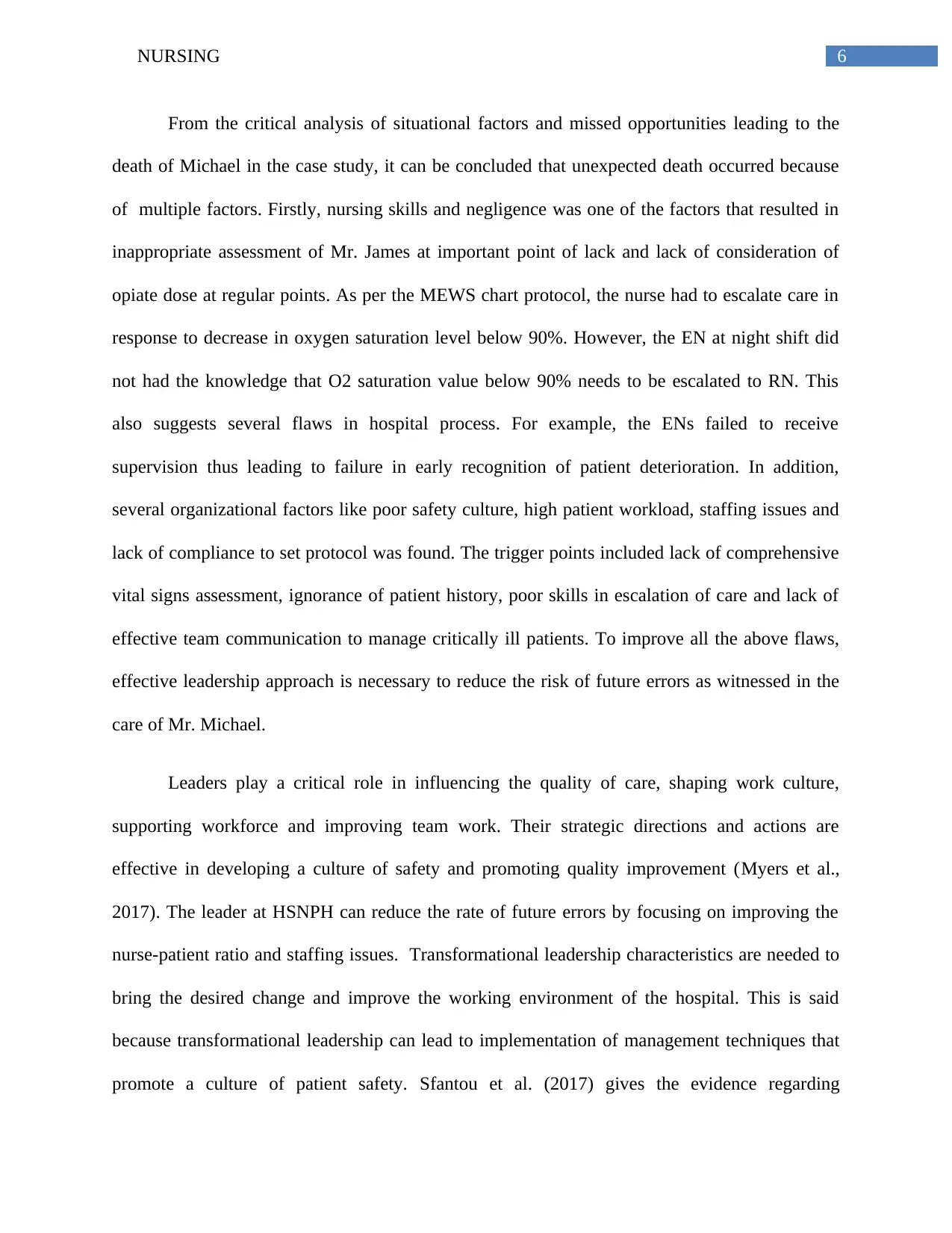
6NURSING
From the critical analysis of situational factors and missed opportunities leading to the
death of Michael in the case study, it can be concluded that unexpected death occurred because
of multiple factors. Firstly, nursing skills and negligence was one of the factors that resulted in
inappropriate assessment of Mr. James at important point of lack and lack of consideration of
opiate dose at regular points. As per the MEWS chart protocol, the nurse had to escalate care in
response to decrease in oxygen saturation level below 90%. However, the EN at night shift did
not had the knowledge that O2 saturation value below 90% needs to be escalated to RN. This
also suggests several flaws in hospital process. For example, the ENs failed to receive
supervision thus leading to failure in early recognition of patient deterioration. In addition,
several organizational factors like poor safety culture, high patient workload, staffing issues and
lack of compliance to set protocol was found. The trigger points included lack of comprehensive
vital signs assessment, ignorance of patient history, poor skills in escalation of care and lack of
effective team communication to manage critically ill patients. To improve all the above flaws,
effective leadership approach is necessary to reduce the risk of future errors as witnessed in the
care of Mr. Michael.
Leaders play a critical role in influencing the quality of care, shaping work culture,
supporting workforce and improving team work. Their strategic directions and actions are
effective in developing a culture of safety and promoting quality improvement (Myers et al.,
2017). The leader at HSNPH can reduce the rate of future errors by focusing on improving the
nurse-patient ratio and staffing issues. Transformational leadership characteristics are needed to
bring the desired change and improve the working environment of the hospital. This is said
because transformational leadership can lead to implementation of management techniques that
promote a culture of patient safety. Sfantou et al. (2017) gives the evidence regarding
From the critical analysis of situational factors and missed opportunities leading to the
death of Michael in the case study, it can be concluded that unexpected death occurred because
of multiple factors. Firstly, nursing skills and negligence was one of the factors that resulted in
inappropriate assessment of Mr. James at important point of lack and lack of consideration of
opiate dose at regular points. As per the MEWS chart protocol, the nurse had to escalate care in
response to decrease in oxygen saturation level below 90%. However, the EN at night shift did
not had the knowledge that O2 saturation value below 90% needs to be escalated to RN. This
also suggests several flaws in hospital process. For example, the ENs failed to receive
supervision thus leading to failure in early recognition of patient deterioration. In addition,
several organizational factors like poor safety culture, high patient workload, staffing issues and
lack of compliance to set protocol was found. The trigger points included lack of comprehensive
vital signs assessment, ignorance of patient history, poor skills in escalation of care and lack of
effective team communication to manage critically ill patients. To improve all the above flaws,
effective leadership approach is necessary to reduce the risk of future errors as witnessed in the
care of Mr. Michael.
Leaders play a critical role in influencing the quality of care, shaping work culture,
supporting workforce and improving team work. Their strategic directions and actions are
effective in developing a culture of safety and promoting quality improvement (Myers et al.,
2017). The leader at HSNPH can reduce the rate of future errors by focusing on improving the
nurse-patient ratio and staffing issues. Transformational leadership characteristics are needed to
bring the desired change and improve the working environment of the hospital. This is said
because transformational leadership can lead to implementation of management techniques that
promote a culture of patient safety. Sfantou et al. (2017) gives the evidence regarding
Paraphrase This Document
Need a fresh take? Get an instant paraphrase of this document with our AI Paraphraser
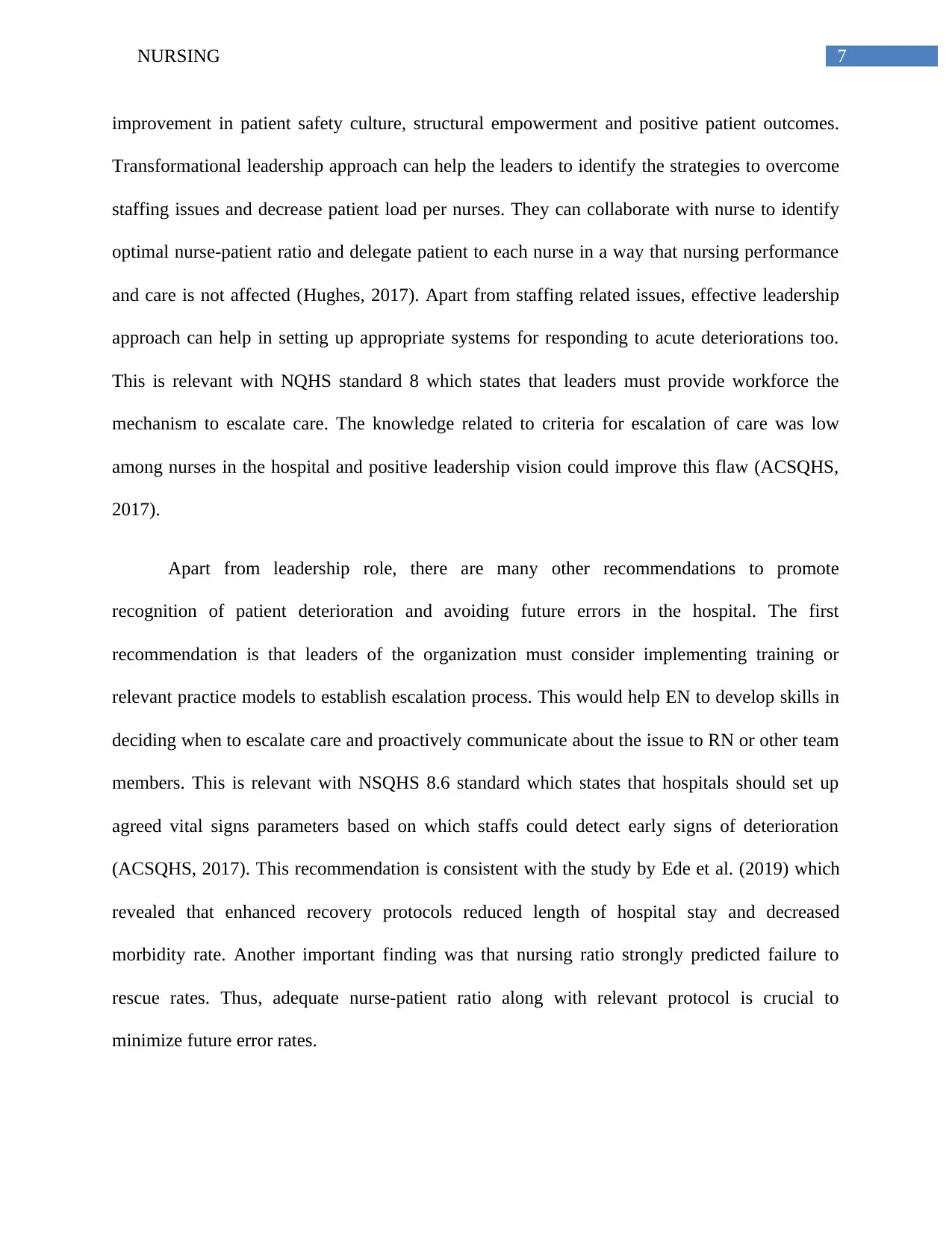
7NURSING
improvement in patient safety culture, structural empowerment and positive patient outcomes.
Transformational leadership approach can help the leaders to identify the strategies to overcome
staffing issues and decrease patient load per nurses. They can collaborate with nurse to identify
optimal nurse-patient ratio and delegate patient to each nurse in a way that nursing performance
and care is not affected (Hughes, 2017). Apart from staffing related issues, effective leadership
approach can help in setting up appropriate systems for responding to acute deteriorations too.
This is relevant with NQHS standard 8 which states that leaders must provide workforce the
mechanism to escalate care. The knowledge related to criteria for escalation of care was low
among nurses in the hospital and positive leadership vision could improve this flaw (ACSQHS,
2017).
Apart from leadership role, there are many other recommendations to promote
recognition of patient deterioration and avoiding future errors in the hospital. The first
recommendation is that leaders of the organization must consider implementing training or
relevant practice models to establish escalation process. This would help EN to develop skills in
deciding when to escalate care and proactively communicate about the issue to RN or other team
members. This is relevant with NSQHS 8.6 standard which states that hospitals should set up
agreed vital signs parameters based on which staffs could detect early signs of deterioration
(ACSQHS, 2017). This recommendation is consistent with the study by Ede et al. (2019) which
revealed that enhanced recovery protocols reduced length of hospital stay and decreased
morbidity rate. Another important finding was that nursing ratio strongly predicted failure to
rescue rates. Thus, adequate nurse-patient ratio along with relevant protocol is crucial to
minimize future error rates.
improvement in patient safety culture, structural empowerment and positive patient outcomes.
Transformational leadership approach can help the leaders to identify the strategies to overcome
staffing issues and decrease patient load per nurses. They can collaborate with nurse to identify
optimal nurse-patient ratio and delegate patient to each nurse in a way that nursing performance
and care is not affected (Hughes, 2017). Apart from staffing related issues, effective leadership
approach can help in setting up appropriate systems for responding to acute deteriorations too.
This is relevant with NQHS standard 8 which states that leaders must provide workforce the
mechanism to escalate care. The knowledge related to criteria for escalation of care was low
among nurses in the hospital and positive leadership vision could improve this flaw (ACSQHS,
2017).
Apart from leadership role, there are many other recommendations to promote
recognition of patient deterioration and avoiding future errors in the hospital. The first
recommendation is that leaders of the organization must consider implementing training or
relevant practice models to establish escalation process. This would help EN to develop skills in
deciding when to escalate care and proactively communicate about the issue to RN or other team
members. This is relevant with NSQHS 8.6 standard which states that hospitals should set up
agreed vital signs parameters based on which staffs could detect early signs of deterioration
(ACSQHS, 2017). This recommendation is consistent with the study by Ede et al. (2019) which
revealed that enhanced recovery protocols reduced length of hospital stay and decreased
morbidity rate. Another important finding was that nursing ratio strongly predicted failure to
rescue rates. Thus, adequate nurse-patient ratio along with relevant protocol is crucial to
minimize future error rates.

8NURSING
The second recommendation is to improve team related communication in response to
signs of deterioration. This recommendation has been made because both Dr Brockett as well as
the nurse admitted that many crucial information like decrease in oxygen saturation rate was not
communicated to them on time. The leader of the organization can work to improve team
communication and develop a supportive team which is vigilant and communicated important
message to each member on time. Focus in this area is important to ensure that each member
recognize each other’s expertise and know exactly when the staffs must intervene to control risk
events in hospital. Team communication can also enhance trust and ensure that culture of blame
is not seen in the future in case of unnecessary adverse events (Massey, Chaboyer & Anderson,
2017). The third recommendation is to develop the skills among staffs to effectively manage
opioid overdose and observe patients who need opioid for pain management. This is necessary to
prevent opioid related toxicity. The staffs must be given training on clinical manifestations of
opioid overdose, the risk of opioid toxicity in patients with sleep apnea and significance of vital
sign assessment and physical examination during opioid administration. They must have the
knowledge to identify the parameters or situation during which oxygenation and restoration of
ventilation should take place (Boyer, 2012).
Conclusion:
From the critical evaluation of the events contributing to death of Mr. James, it can be
concluded comprehensive assessment, knowledge about early warning signs and steps to escalate
care is crucial to prevent unexpected death. The essay recognized several pitfalls in the case of
Mr. James and this ranged for nursing negligence to lack of skills to escalate care along with
combination of organizational factors too. In response to the events triggering the negative
events, the essay recommends implementation of effective leadership approach so that safety
The second recommendation is to improve team related communication in response to
signs of deterioration. This recommendation has been made because both Dr Brockett as well as
the nurse admitted that many crucial information like decrease in oxygen saturation rate was not
communicated to them on time. The leader of the organization can work to improve team
communication and develop a supportive team which is vigilant and communicated important
message to each member on time. Focus in this area is important to ensure that each member
recognize each other’s expertise and know exactly when the staffs must intervene to control risk
events in hospital. Team communication can also enhance trust and ensure that culture of blame
is not seen in the future in case of unnecessary adverse events (Massey, Chaboyer & Anderson,
2017). The third recommendation is to develop the skills among staffs to effectively manage
opioid overdose and observe patients who need opioid for pain management. This is necessary to
prevent opioid related toxicity. The staffs must be given training on clinical manifestations of
opioid overdose, the risk of opioid toxicity in patients with sleep apnea and significance of vital
sign assessment and physical examination during opioid administration. They must have the
knowledge to identify the parameters or situation during which oxygenation and restoration of
ventilation should take place (Boyer, 2012).
Conclusion:
From the critical evaluation of the events contributing to death of Mr. James, it can be
concluded comprehensive assessment, knowledge about early warning signs and steps to escalate
care is crucial to prevent unexpected death. The essay recognized several pitfalls in the case of
Mr. James and this ranged for nursing negligence to lack of skills to escalate care along with
combination of organizational factors too. In response to the events triggering the negative
events, the essay recommends implementation of effective leadership approach so that safety
⊘ This is a preview!⊘
Do you want full access?
Subscribe today to unlock all pages.

Trusted by 1+ million students worldwide
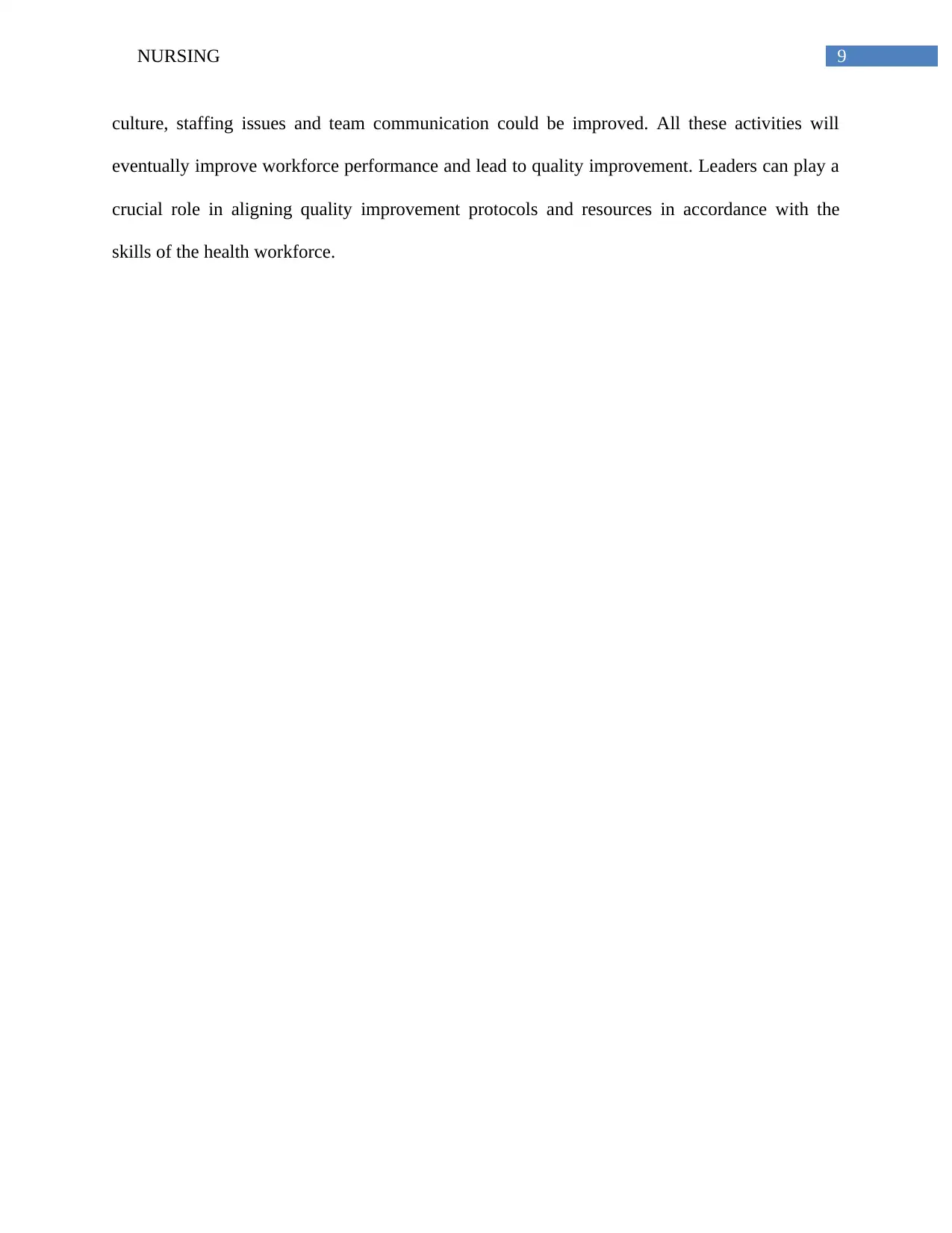
9NURSING
culture, staffing issues and team communication could be improved. All these activities will
eventually improve workforce performance and lead to quality improvement. Leaders can play a
crucial role in aligning quality improvement protocols and resources in accordance with the
skills of the health workforce.
culture, staffing issues and team communication could be improved. All these activities will
eventually improve workforce performance and lead to quality improvement. Leaders can play a
crucial role in aligning quality improvement protocols and resources in accordance with the
skills of the health workforce.
Paraphrase This Document
Need a fresh take? Get an instant paraphrase of this document with our AI Paraphraser

10NURSING
References:
Anstey, M. H., Bhasale, A., Dunbar, N. J., & Buchan, H. (2019). Recognising and responding to
deteriorating patients: what difference do national standards make?. BMC health services
research, 19(1), 639. https://doi.org/10.1186/s12913-019-4339-z
Australian Commission on Safety and Quality in Health Care (ACSQHS) 2017. National Safety
and Quality Health Service Standards. Retrieved from:
https://www.safetyandquality.gov.au/sites/default/files/migrated/National-Safety-and-
Quality-Health-Service-Standards-second-edition.pdf
Berk, J., Rogers, K. M., Wilson, D. J., Thakrar, A., & Feldman, L. (2019). Missed Opportunities
for Treatment of Opioid Use Disorder in the Hospital Setting: Updating an Outdated
Policy. Journal of hospital medicine, 14, E1.
Boyer, E. W. (2012). Management of opioid analgesic overdose. New England Journal of
Medicine, 367(2), 146-155. doi: 10.1056/NEJMra1202561
Cheatle, M. D., & Webster, L. R. (2015). Opioid therapy and sleep disorders: risks and
mitigation strategies. Pain Medicine, 16(suppl_1), S22-S26.doi: 10.1111/pme.12910
Ede, J., Jeffs, E., Vollam, S., & Watkinson, P. (2019). A qualitative exploration of escalation of
care in the acute ward setting. Nursing in Critical Care. DOI: 10.1111/nicc.12479
References:
Anstey, M. H., Bhasale, A., Dunbar, N. J., & Buchan, H. (2019). Recognising and responding to
deteriorating patients: what difference do national standards make?. BMC health services
research, 19(1), 639. https://doi.org/10.1186/s12913-019-4339-z
Australian Commission on Safety and Quality in Health Care (ACSQHS) 2017. National Safety
and Quality Health Service Standards. Retrieved from:
https://www.safetyandquality.gov.au/sites/default/files/migrated/National-Safety-and-
Quality-Health-Service-Standards-second-edition.pdf
Berk, J., Rogers, K. M., Wilson, D. J., Thakrar, A., & Feldman, L. (2019). Missed Opportunities
for Treatment of Opioid Use Disorder in the Hospital Setting: Updating an Outdated
Policy. Journal of hospital medicine, 14, E1.
Boyer, E. W. (2012). Management of opioid analgesic overdose. New England Journal of
Medicine, 367(2), 146-155. doi: 10.1056/NEJMra1202561
Cheatle, M. D., & Webster, L. R. (2015). Opioid therapy and sleep disorders: risks and
mitigation strategies. Pain Medicine, 16(suppl_1), S22-S26.doi: 10.1111/pme.12910
Ede, J., Jeffs, E., Vollam, S., & Watkinson, P. (2019). A qualitative exploration of escalation of
care in the acute ward setting. Nursing in Critical Care. DOI: 10.1111/nicc.12479
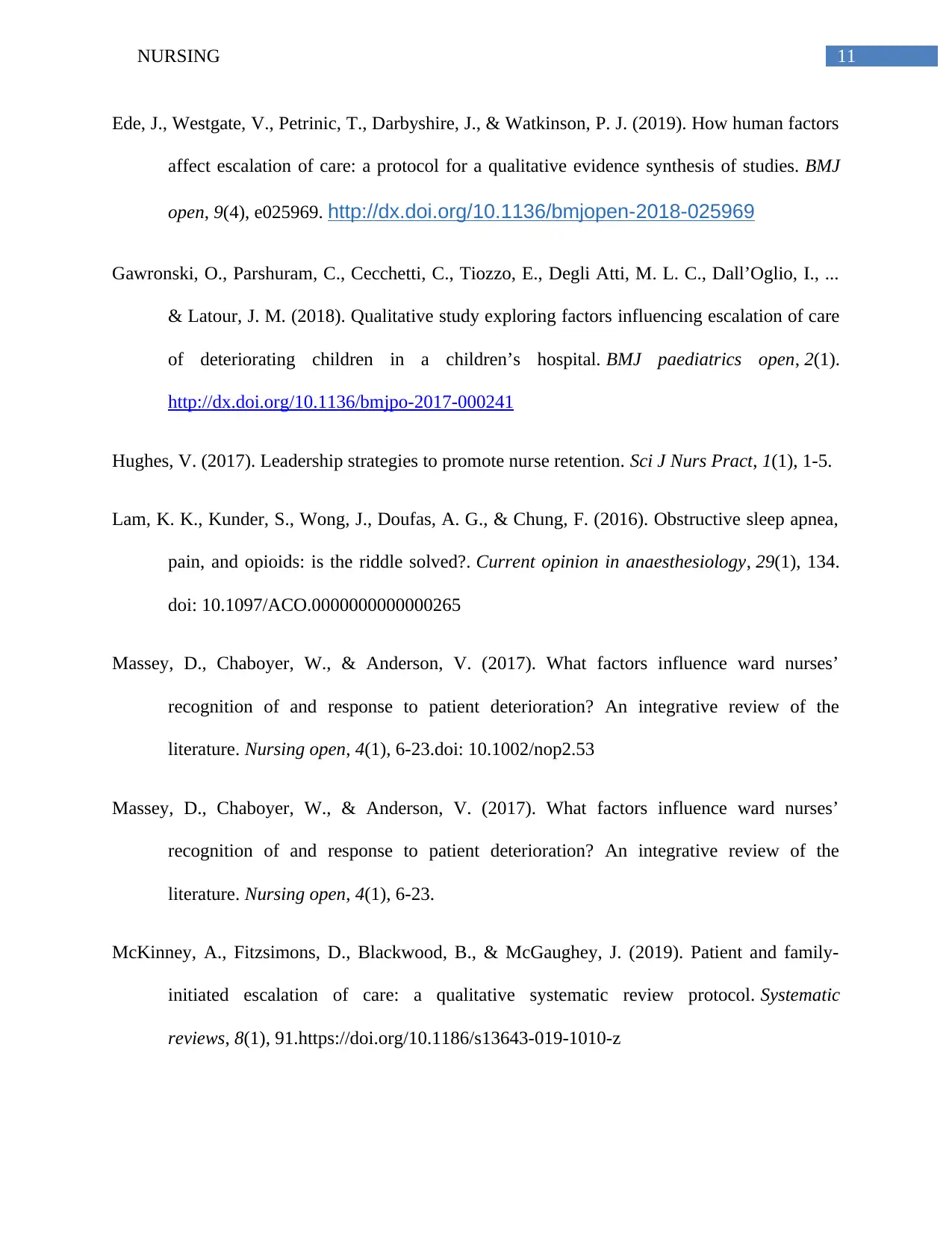
11NURSING
Ede, J., Westgate, V., Petrinic, T., Darbyshire, J., & Watkinson, P. J. (2019). How human factors
affect escalation of care: a protocol for a qualitative evidence synthesis of studies. BMJ
open, 9(4), e025969. http://dx.doi.org/10.1136/bmjopen-2018-025969
Gawronski, O., Parshuram, C., Cecchetti, C., Tiozzo, E., Degli Atti, M. L. C., Dall’Oglio, I., ...
& Latour, J. M. (2018). Qualitative study exploring factors influencing escalation of care
of deteriorating children in a children’s hospital. BMJ paediatrics open, 2(1).
http://dx.doi.org/10.1136/bmjpo-2017-000241
Hughes, V. (2017). Leadership strategies to promote nurse retention. Sci J Nurs Pract, 1(1), 1-5.
Lam, K. K., Kunder, S., Wong, J., Doufas, A. G., & Chung, F. (2016). Obstructive sleep apnea,
pain, and opioids: is the riddle solved?. Current opinion in anaesthesiology, 29(1), 134.
doi: 10.1097/ACO.0000000000000265
Massey, D., Chaboyer, W., & Anderson, V. (2017). What factors influence ward nurses’
recognition of and response to patient deterioration? An integrative review of the
literature. Nursing open, 4(1), 6-23.doi: 10.1002/nop2.53
Massey, D., Chaboyer, W., & Anderson, V. (2017). What factors influence ward nurses’
recognition of and response to patient deterioration? An integrative review of the
literature. Nursing open, 4(1), 6-23.
McKinney, A., Fitzsimons, D., Blackwood, B., & McGaughey, J. (2019). Patient and family-
initiated escalation of care: a qualitative systematic review protocol. Systematic
reviews, 8(1), 91.https://doi.org/10.1186/s13643-019-1010-z
Ede, J., Westgate, V., Petrinic, T., Darbyshire, J., & Watkinson, P. J. (2019). How human factors
affect escalation of care: a protocol for a qualitative evidence synthesis of studies. BMJ
open, 9(4), e025969. http://dx.doi.org/10.1136/bmjopen-2018-025969
Gawronski, O., Parshuram, C., Cecchetti, C., Tiozzo, E., Degli Atti, M. L. C., Dall’Oglio, I., ...
& Latour, J. M. (2018). Qualitative study exploring factors influencing escalation of care
of deteriorating children in a children’s hospital. BMJ paediatrics open, 2(1).
http://dx.doi.org/10.1136/bmjpo-2017-000241
Hughes, V. (2017). Leadership strategies to promote nurse retention. Sci J Nurs Pract, 1(1), 1-5.
Lam, K. K., Kunder, S., Wong, J., Doufas, A. G., & Chung, F. (2016). Obstructive sleep apnea,
pain, and opioids: is the riddle solved?. Current opinion in anaesthesiology, 29(1), 134.
doi: 10.1097/ACO.0000000000000265
Massey, D., Chaboyer, W., & Anderson, V. (2017). What factors influence ward nurses’
recognition of and response to patient deterioration? An integrative review of the
literature. Nursing open, 4(1), 6-23.doi: 10.1002/nop2.53
Massey, D., Chaboyer, W., & Anderson, V. (2017). What factors influence ward nurses’
recognition of and response to patient deterioration? An integrative review of the
literature. Nursing open, 4(1), 6-23.
McKinney, A., Fitzsimons, D., Blackwood, B., & McGaughey, J. (2019). Patient and family-
initiated escalation of care: a qualitative systematic review protocol. Systematic
reviews, 8(1), 91.https://doi.org/10.1186/s13643-019-1010-z
⊘ This is a preview!⊘
Do you want full access?
Subscribe today to unlock all pages.

Trusted by 1+ million students worldwide
1 out of 13
Related Documents
Your All-in-One AI-Powered Toolkit for Academic Success.
+13062052269
info@desklib.com
Available 24*7 on WhatsApp / Email
![[object Object]](/_next/static/media/star-bottom.7253800d.svg)
Unlock your academic potential
Copyright © 2020–2025 A2Z Services. All Rights Reserved. Developed and managed by ZUCOL.





